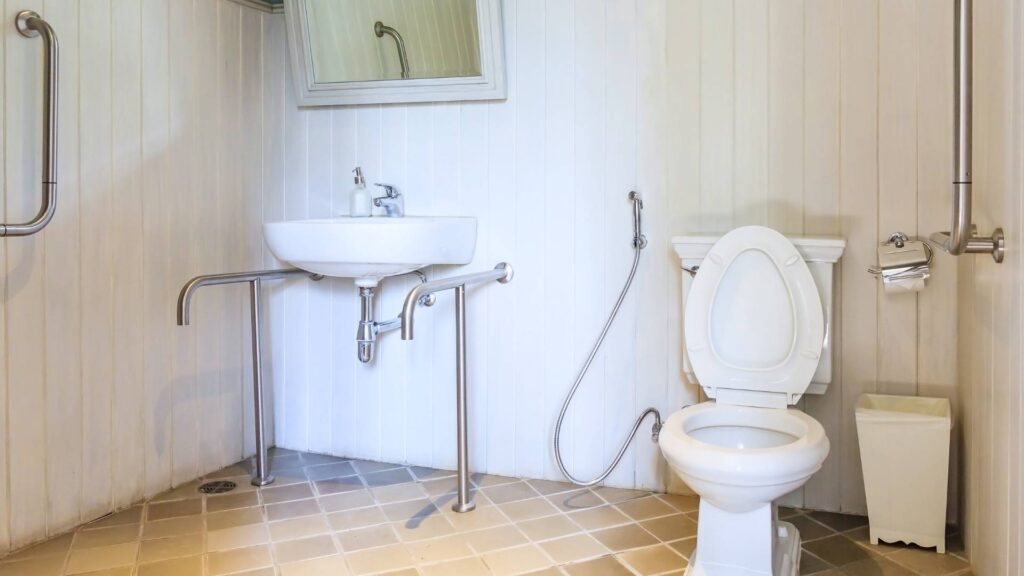As a landlord, ensuring your rental property is accessible and safe for all tenants is not only a legal responsibility but also a way to attract a broader tenant pool, including those with disabilities. Bathrooms, in particular, require special attention when making a rental property ADA-compliant. They are one of the most utilized spaces in a home and can pose significant challenges for individuals with mobility impairments if not properly designed. In this guide, we’ll focus on the key aspects of making bathrooms in your rental property ADA-compliant, helping you create a more inclusive and accessible living environment.
Why ADA-Compliant Bathrooms Matter
Bathrooms are a high-risk area for slips, falls, and other accidents, especially for individuals with disabilities. Making bathrooms ADA-compliant is crucial to ensure that all tenants, regardless of physical ability, can use these spaces safely and independently. An ADA-compliant bathroom not only enhances the safety and comfort of tenants but also increases the appeal and value of your rental property.
Key Bathroom Modifications for ADA Compliance
1. Grab Bars
One of the most critical elements in an ADA-compliant bathroom is the installation of grab bars. Grab bars provide essential support for individuals when moving around the bathroom, such as getting in and out of the shower or using the toilet. According to ADA guidelines, grab bars should be installed near the toilet and in the shower or bathtub area.
- Placement: Grab bars should be placed at a height of 33 to 36 inches from the floor. For toilets, they should be mounted on the side wall closest to the toilet and behind the toilet for maximum support. In showers and bathtubs, grab bars should be positioned horizontally along the walls.
- Installation: It’s important to ensure that grab bars are securely anchored to the wall to support at least 250 pounds of force. Working with professionals like Handi Bath Remodeling can ensure proper installation that meets ADA standards.
2. Roll-In Showers and Walk-In Tubs
Showers and tubs are areas where many accidents occur due to wet, slippery surfaces. ADA-compliant roll-in showers and walk-in tubs provide safer alternatives for tenants with disabilities.
- Roll-In Showers: These showers are designed with a low or no threshold, allowing individuals in wheelchairs to roll directly into the shower. The shower should also include a built-in bench and handheld showerhead for ease of use.
- Walk-In Tubs: These tubs have a door that opens, allowing tenants to step in without having to climb over the side of the tub. They also feature built-in seating, making bathing safer and more comfortable for individuals with mobility challenges.
3. Accessible Sinks and Vanities
Standard sinks and vanities can be difficult to use for individuals in wheelchairs. To make your bathroom ADA-compliant, consider installing accessible sinks and vanities that accommodate tenants with disabilities.
- Height: Sinks should be mounted no higher than 34 inches from the floor. There should be enough knee clearance (at least 27 inches high, 30 inches wide, and 11-25 inches deep) underneath the sink to allow a wheelchair to roll under.
- Faucets: Lever-operated, push, or touchless faucets are recommended for ADA-compliant bathrooms, as they are easier to operate for individuals with limited hand strength or dexterity.
4. Toilet Modifications
The toilet is another critical area where ADA compliance is essential. An ADA-compliant toilet must meet specific height and space requirements to ensure it is accessible to all tenants.
- Height: ADA-compliant toilets should have a seat height of 17 to 19 inches from the floor. This height makes it easier for individuals with mobility impairments to sit down and stand up.
- Space: There should be enough clear floor space around the toilet (at least 60 inches from the side wall and 56 inches from the back wall) to accommodate a wheelchair.
5. Non-Slip Flooring
The bathroom floor can become slippery, especially when wet, which poses a significant risk for falls. Installing non-slip flooring is a simple yet effective way to enhance safety in an ADA-compliant bathroom.
- Material: Choose flooring materials with a textured surface that provides traction even when wet. Vinyl, rubber, and certain types of tile are popular choices for non-slip bathroom flooring.
- Maintenance: Regular maintenance, such as keeping floors dry and free of clutter, further enhances safety for all tenants.
Legal Considerations for Landlords
Landlords are legally required to make reasonable modifications to rental properties to accommodate tenants with disabilities under the Fair Housing Act (FHA). This includes making necessary adjustments to bathrooms to ensure they are accessible. While tenants may bear the cost of these modifications, landlords must allow them to make changes to the unit to meet their accessibility needs.
For common areas in multifamily properties, such as shared bathrooms in apartment complexes, ADA compliance is mandatory. Failing to meet these requirements can result in legal penalties and restrict your ability to attract and retain tenants.
Working with Professionals
When making ADA-compliant modifications to bathrooms, it’s essential to work with experienced professionals who understand the specific requirements of ADA guidelines. Handi Bath Remodeling specializes in ADA bathroom designs and can help you make the necessary modifications to ensure your rental property is safe, accessible, and compliant with all legal standards.
Conclusion
Making bathrooms in your rental property ADA-compliant is a crucial step in creating a safe and accessible living environment for all tenants. By focusing on key modifications like grab bars, roll-in showers, accessible sinks, and non-slip flooring, you can significantly reduce the risk of accidents and improve the quality of life for tenants with disabilities. Partnering with experts like Handi Bath Remodeling ensures that these modifications are done correctly, meeting both legal requirements and the needs of your tenants.


